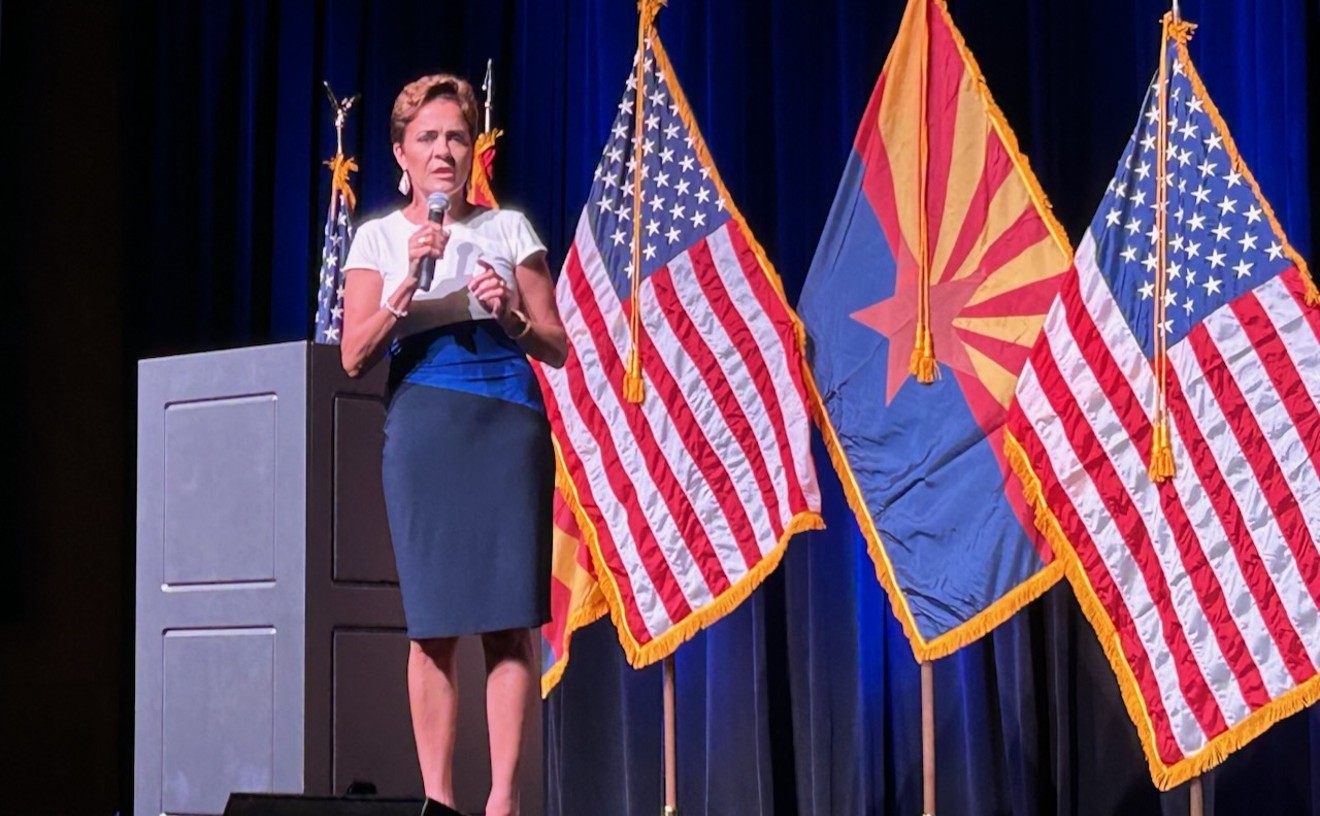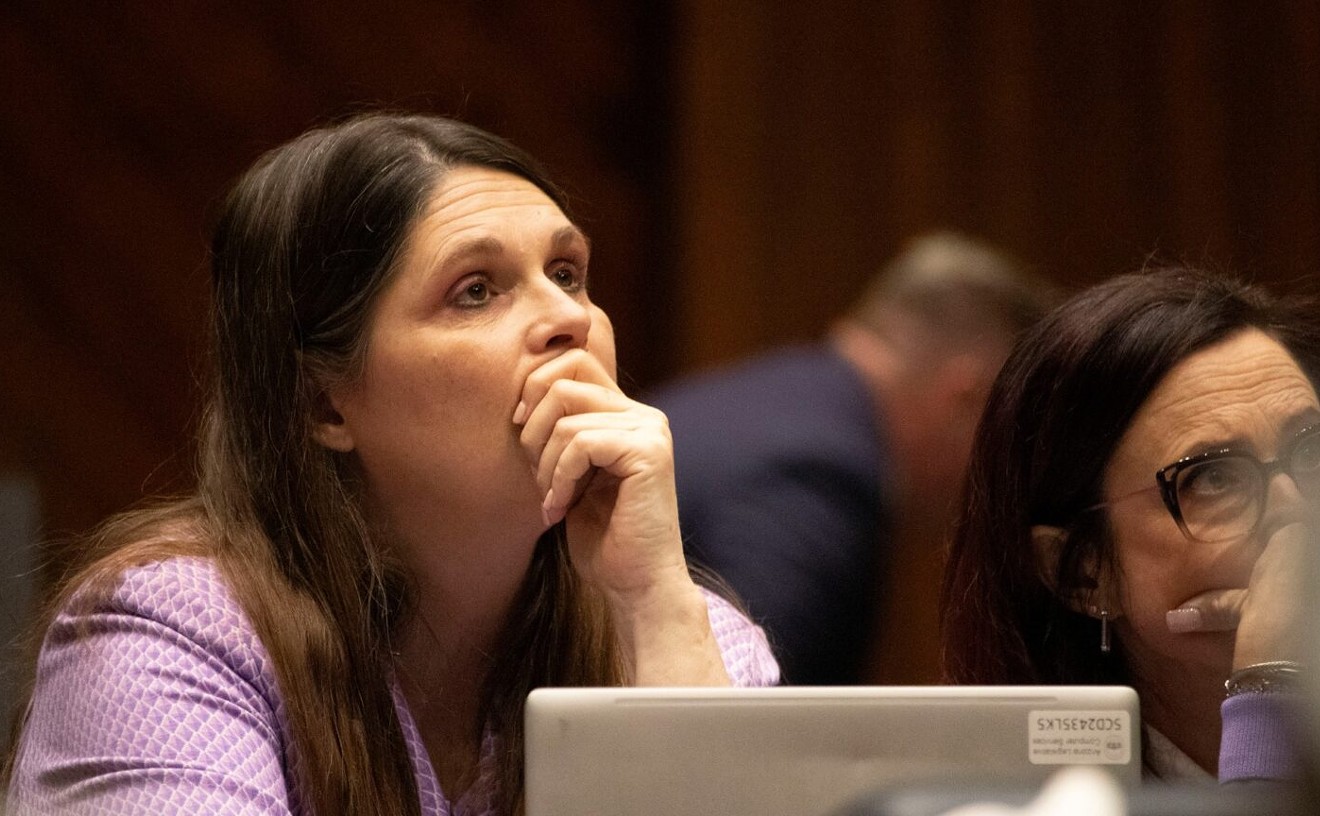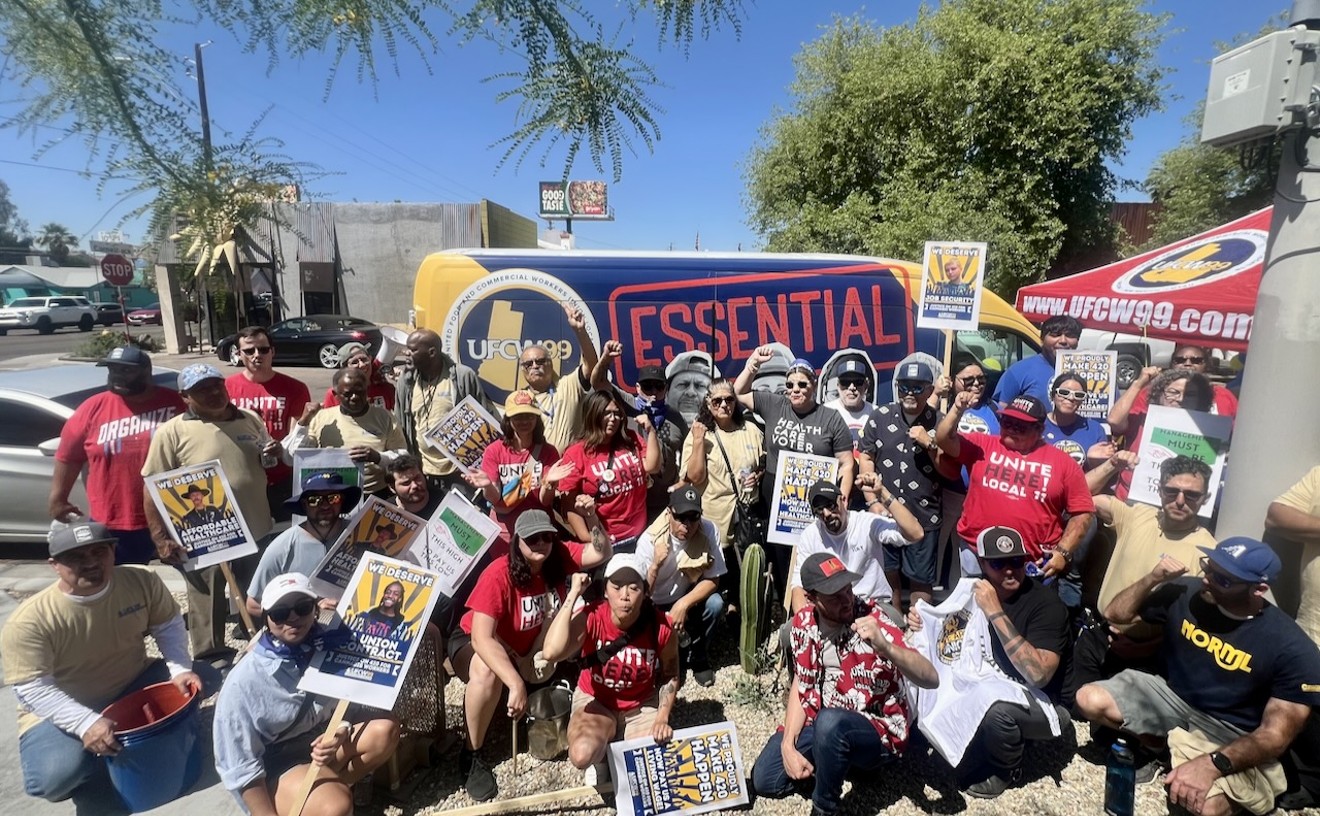"To run three acres of land without God is really complicated."
There's no debating a statement like that, but getting into the minibar in Room 16 at the Biosphere Hotel is not without its own level of complexity.
And it doesn't take a geochemist to tell you this, all it takes is a journalist. One who was awake sometime past midnight last week trying to wedge his room key into the lock of the thing, one who couldn't raise anyone at the front desk, one who could not find a bendable coat hanger or any other contraption with which to pry it open. One who, like Broecker, invoked God, repeatedly petitioning him to damn the apparently sealed-'til-doomsday minibar.
That was me. All I wanted was a beer and a bag of chips, maybe some Mr. Boston Bloody Mary mix, something to take the edge off my nervous anticipation over the activities awaiting me the next morning.
I was going to enter Biosphere 2.
Which I did--and I'll tell you all about it.
But I never did get into the minibar. And when you're a guest at the Biosphere Hotel (sometimes referred to as The Inn at Biosphere), it's not like you can just drive a couple blocks to a Circle K for your life-sustaining necessities. For, as the name might imply, the Biosphere Hotel is located next to Biosphere 2. That location is miles away from the nearest town, in a secluded patch of desert at the end of a private road behind two guardhouses, a number of speed bumps and three cattle guards.
Yet the tourists are coming, especially since prestigious Columbia University of New York took over management in January '96 and opened the Biosphere structure itself to the public for the first time last November. The university's aim was to provide "new educational, research and visitors programs," according to the Biosphere 2 brochure that I found in my hotel room, apparently in lieu of a Gideon Bible. "New exhibits have been developed. And computers in the on-site Cyber Cafe now let visitors cruise the Internet to learn more about our complex planet and its environment."
Ah, the Cyber Cafe. When they tire of cruising, visitors can also purchase CDs of Jazz Loon, Beethoven Naturally, Summer Breeze, Dolphin Dreams or Early Morning in Rain Forest. Or Biosphere 2 squeeze bottles, mugs, mouse pads, even a refrigerator magnet with your name on it. Unless you have a very popular name that is temporarily out of stock--"John," for instance--in which case you might have to settle for the more intrepid-sounding "Johnny."
But Biosphere offers much more than marketing trinkets and an otherworldly college campus. Despite the stubborn minibar, my hotel room was large and plush with a king-size bed, cable TV and a fabulous view of the Santa Catalina Mountains featuring snowcapped Mount Lemmon.
Tennis, anyone? When you want to put down the slide rule, slip out of the pocket protector and take a break from learning about that pesky greenhouse effect, there are two courts waiting for you to slap the Spalding. They're right next to the swimming pool, shaped like an enormous organically fed kidney, adjacent to the Biofair.
Yes, the Biofair. Bring the whole family and enjoy "interactive science activities" such as the Eco-Maze, Chaotic Pendulum, 6-Foot Tornado, Aeolian Landscape and Soap Bubbles.
All of which pale in comparison to the main attraction. Call it a New Age research-and-education facility, call it the unique ecological laboratory on the planet, call it one of the oddest resorts that will ever grace a travel brochure; it is Biosphere 2.
It sits there on 3.15 acres of desert, looking like a mix between Reverend Robert Schuller's Crystal Cathedral and the It's a Small World ride at Disneyland. And it really is a small world, after all, one with the moxie to name itself after the big one it was created to ape. (In case you didn't know, "Biosphere 1" is another name for the planet Earth.)
No. 2 boasts five self-sustaining communities of living organisms, or "biomes," as they say in spherese. There's a rain forest, desert, savannah, marsh, ocean and more than 3,000 species of those aforementioned organisms growing, multiplying and doing pretty much the same things that they'd be doing "out there" in Biosphere 1.
Though most Arizona residents probably know the history backward and forward, here's a brief refresher on Biosphere Deux:
It was built with the money from oil-heir millionaire Edward Bass by a group--some say "cult"--led by John "Johnny Dolphin" Allen. He used the big Bass bucks to purchase the brains and expertise of scientists from the Smithsonian, Yale University, the New York Botanical Gardens and the University of Arizona, among others.
Then on September 26, 1991, eight Biosphereans entered the "human enclosure" for a two-year period on an internationally acclaimed mission to live independently of the Earth's atmosphere. They imported plants, animals and insects, grew their own food, recycled their own waste, developed their own life-support chain. The Biosphereans' goal was to determine how to preserve and control the planet's life systems, information that would come in handy if we ever need to set up shop on Mars.
A second group of seven went in in 1994, but lasted only six-and-a-half months. These Biosphereans spent so much time working the crops and engaging in other basic survival chores that they had little time for scientific research.
What were the results? Well, as the New York Times recently reported, "the would-be Eden became a nightmare, its atmosphere gone sour, its sea acidic, its crops failing and many of its species dying off."
But all of that is in the past, now that Columbia University has taken over. That whole glorious sci-fi element is gone--no more smiling Biosphereans tramping about in red jump suits with "BIO 2" patches sewn over their hearts. Or brave, vaguely silly space farmers in a monstrous glass pyramid probing the possibility of a self-sufficient New Age existence for the benefit of all humankind.
Today, the site combines research with pleasure, resortlike recreation with scientific credibility, a place where students (there are 52 of them from around the world in attendance presently) can study as Mom, Dad and Sis gasp and boggle at the ex-living quarters of the Biosphereans, take a tumble in the wacky Eco-Tube and top off the day with a fine meal at the Canyon Cafe with a chilled bottle of Kendall Jackson Chardonnay.
Just don't forget, dinner reservations are required.
It is the afternoon before I am to enter Biosphere 2. I have planted my bags in the hotel room, and I have driven into the closest town, Oracle.
There is not a lot to do in Oracle on a Tuesday night, here in Biosphere 1. I stop at the Hildreth Market. It has a general-store feel to it, and--other than the impressive rack of porn in the anachronistically labeled "Family Reading Center" rack--it's someplace Aunt Bea would shop. Right by the cash register, it's got flash cubes for sale.
Two young women who look about 19, one with a toddler in a diaper, are standing there putting coins into a machine that will make funny ducklike sounds and drop an egg filled with candy.
We start talking about where to eat in town, and when they find out I'm staying at the Biosphere Hotel, they recoil in horror.
"They got scorpions in the beds!" yells the woman without the toddler. This woman has a large tattoo of the Tasmanian Devil on her leg.
"Scorpions?" I reply. "How do you know?"
"We used to work there!"
I'm thinking they don't look like scientists.
"We were maids." Maids, wow. Not even "housekeepers."
"How long did you guys work there?"
"I was there three months," says the tattooed one.
"Yeah, and I was there a day!" says the other one. "I saw a scorpion in the toilet and I ran out of there screaming like shit!" She reenacts this intense scene, clutching her head with both hands, accenting the screaming like shit. "Sometimes there's scorpions in the Kleenex boxes," she continues. "They like to get in there where it's dark."
During all of this, the stately, vaguely Hispanic-looking woman behind the counter stares and shakes her head. I thank the young women for the lowdown and wave them out the door, and the woman speaks.
"Don't believe what they tell you." She lowers her voice, even though we're the only people in the place. "They got fired." She smiles wisely. "Those two, I've known them since they were born, and now they're boy-crazy," she says, as if that explains everything. It explains the toddler; what it reveals about the scorpions I don't know.
"But they're young girls," she continues, "what do you expect? I like Biosphere. I think it's educational."
And, for the record, Room 16 was scorpion-free.
At 10 a.m. the next morning, it is eerily quiet at Biosphere 2. There is the feeling of an amusement park closed down for cleaning. My tour will begin across from the Rain Forest Gift Shop next to the solar panels, and as I wait there, a small pastel battalion of senior citizens gathers.
These are to be my tour mates.
Our first stop is at the Biome Demonstration Laboratories, where miniversions of the various ecosystems found in Biosphere 2 were developed. It's raining in the rain forest, and the room is flush with plants. One, our guide Amelia explains, is the kapok tree. Its inner husk is very buoyant and is used to stuff life preservers, despite that it is also very flammable. "You take the good with the bad," Amelia says with a giggle.
We travel through the other demo-biomes, which is pretty much like walking through a big greenhouse. If you enjoy greenhouses, this is great fun. There's the prototype ocean, murky green water in a deep glass-windowed tank, and next to it a stack of boxes labeled "Instant Ocean."
"That's what they use in the ocean biome," Amelia reveals to me, to which I reply, "Oh, just add water, eh?" To which she says "That's right."
Mere steps away from entering Biosphere 2, the legendary mother ship herself, I inhale deeply. The smells riding the desert breeze at that moment are sage, mesquite and a debilitating wave of perfume rising off the collective senior females around me. Back in the old days, that stench alone would have probably sent the fragile, untainted ecosystems of the 'sphere into a death spiral of synthetic impurity.
The "ocean" is right on the other side of the glass, looking like a Disney lagoon minus the drunken robot swashbucklers. Amelia says there are 1 million gallons of water in there--along with plenty of Instant Ocean--teeming with fish and coral and three lobsters. For fun, the Biosphereans used to fling themselves off the cliff into the water, kept at a comfortable 72 degrees. I ask if the employees go in there after hours with six-packs and party on the beach, and she says they don't.
The various other biomes--savannah, rain forest, marsh, desert, etc.--are interesting to check out, but visitors don't get to actually enter these areas. Plus, it's clear that our group is hankering to see the Human Habitat. This is where the Biosphereans indulged in the same pursuits as their brothers and sisters on the outside, and for some reason is a source of fascination.
They did things like cooking, cleaning, sleeping, reading, watching cable, gabbing on the phone, joshing with one another, just as humans may someday do on Mars.
Everything is state-of-the-art, circa early '90s; clean lines, marble table tops, tasteful decorations of modern art. They've got two Julia Child cookbooks in the kitchen, and a posted "typical menu" includes Lab Lab Bean Roast and Lab Lab Bean Soup.
Things are clean and neat and bright, what with the place being made of glass. All the windows and wall panels seem to be diamond shaped. It reminds me of what I imagine a Swedish dormitory would look like. It reminds me of the '70s. I feel as if I should be wearing a turtleneck, chatting with O.J. Simpson in an era when he was getting away with gridiron yardage instead of murder. Some babe in a micro-miniskirt should be tapping me on the shoulder, proffering a doobie of "terrific grass, man!"
Then I get it.
Biosphere 2 is just like the Playboy Mansion.
The similarities are abundant: It has a unique atmosphere unto itself, everybody's curious about it, yet few have actually been there. The grounds are well-manicured and the plant life exotic. Strange species are kept in cages. As the mansion has a manmade, stone-walled grotto, Bio 2 has a manmade, stone-walled lagoon. And, at least ideologically, Hef was an early form of Biospherean, sealing himself up in his self-sufficient habitat without leaving for years! But instead of a red jump suit, he wore silk pajamas, and subsisted on Coke and young blondes instead of organically raised wheat fronds fertilized with his own waste matter.
And he stayed inside much longer than both sets of Biosphereans combined.
The main difference I can see here is that my parents would have stopped at Biosphere 2 on a family vacation and made my sister and me go through it, but they never would have stopped at the Playboy Mansion. And even if they had, we couldn't have gone and toured it, anyway.
Of course, while Hef and his mansion and his ridiculously air-brushed magazine are stuck in time, Biosphere 2, thanks to the guiding academic hand of Columbia University, is working toward the future. Scientific minds that may help the planet combat atmospheric horrors that could someday threaten life as we know it are studiously grinding away.
And, just as I did, you can go witness this for only $12.95. For children 6 to 17, it's $6, and senior citizens, $10.95.
--Gilstrap
If you wish to praise, bury or simply compare inseam sizes with Peter Gilstrap in an electron-based format, modem up our online cousin at: www.phoenixnewtimes.com. The bonus: features so hot they can only appear in a digital bitstream!










